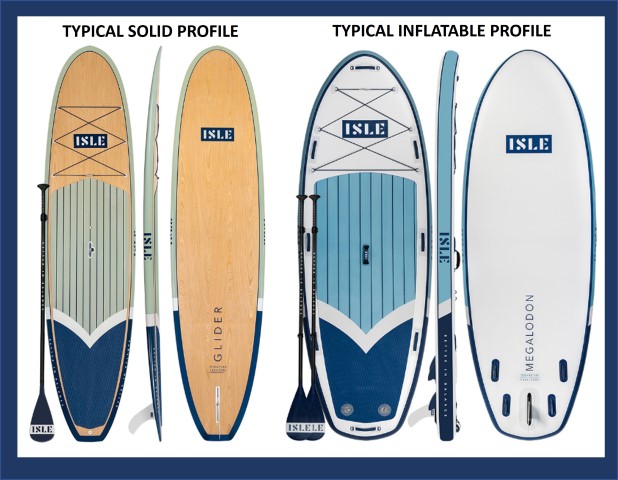Is an inflatable Paddle board preferable to a solid board?
Quick answer:
From a casual users point of view (myself) I would have to say a resounding YES! For these 3 reasons alone. An iSUP is more versatile overall than a solid because it is easier to transport and store, lighter to carry, and a softer platform for Yoga practice!
ISUP vs Solid board in more detail:
Ok, so I’ve ‘nailed my colors to the mast’ from the get-go, but let me explain in just a bit more detail why I would choose an inflatable SUP (iSUP) over a solid board any day of the week.
An ISUP is more portable:
Immediately you may be thinking that I mean an iSUP is easier to transport by car or even public transport because it is in a handy back-pack carry case right? Well of course that alone is a very good reason.
Not everyone relishes the thought of securing a solid board onto their roof-rack and praying it will not come loose and kill someone on the way to the water!
With your iSUP in its carry-case you can simply throw it in the trunk and head away to your destination – no worries.
But more than this…with a portable inflatable paddle board you can visit more remote (and consequently quieter) places where you might even have the run of the place to yourself.
It could be that the lake you fancy paddleboarding in, is a 30 minute walk away (or more) from the nearest spot to park up. This could be a long awkward and physical challenge for the heavier solid board, but with the inflatable in a back-pack it is fundamentally more do-able.
In theory and practice you could carry an ISUP in a back-pack for many miles, and really reach those hidden waterways.
So an inflatable SUP could open up a whole new world of exploration for yourself and your paddleboarding friends and family.

An iSUP is easier to store:
With a solid board you always have to have room to store it – and it does not fold up! This means having space in a garage or car port or just somewhere you can put an 11 foot by 34 inch solid board.
The iSUP on the other hand deflates down into a carry-bag that can be kept in the trunk of the car indefinitely, or put in a corner of the garage or packed away in an under-stair cupboard – you get the idea.
Fair comment is that if you have a high overhead rack in your garage, then this is not a problem – provided you are strong enough to get it up there, and back down again!
An iSUP is lighter to carry:
This is another valid reason why the inflatable is growing in popularity, many (not all) women especially are just not as physically strong as their male counterparts. I’m not being sexist in any way – that’s just the truth of the matter.
Are all inflatables lighter than the solid SUP’s? No they are not. However if you compare like-for-like inflatables vs rigids, the inflatable is a far lighter option.
As a rule the weight for the average ISUP is 15-17 lbs where the hard board can be more than double that at 30-40 lbs.
A good point to note in previous section on storage – can you lift 40lbs to ceiling height?
For a slightly built female to lift a hard board from the roof of the car and get it to the water may be a bit of an endurance trial – which is fine if you are looking for a good workout – just mind the back!
What about the Yoga practice!

Yes indeed I much prefer the inflatable SUP when it comes to Yoga or Pilates practice. The fact is that the inflatable has a bit more ‘give’ to it, rather than the unforgiving hard board.
This is especially so for the elbows and knee joints. There is nothing at all pleasant about crushing your ‘funny bone’ against a hard board (it’s awkward to bring along a padded ground sheet to the paddleboard).
However I would add here that it is also important that you are using a good quality inflatable SUP. Boards that are under 6 inches thick have a tendency to sag in the middle creating a ‘taco’ effect – not good for exercise purposes – or much else really!
Do Hard SUP’s have any advantages over iSUP’s
Yes indeed they do! The fact is that it all depends on your particular needs or requirements when you are deciding between a hard or inflatable SUP.
The benefits of the hard SUP would include…
Better for extreme or competition paddleboarding: The hard SUP tends to be sleeker, quicker through the water, and more manoeuvrable than the inflatable overall.
Similar to surfboards (where the SUP originated), the hard paddle board is much easier for individual makers to customize regarding the shape of the board.
This includes crafting the board for sleeker performance overall and creating profile differences between front, center, and rear of the board according to the use it is being put to.

Easier to manage?
Keeping in mind what I have just written above. The fact is that a hard paddleboard does not have to be inflated regularly like the iSUP (Though even they do not have to be deflated every time after use).
You can simply pick it up and throw it onto the car roof (if you’re able to!) and head off to the water.
Once you get to your destination you can simply head straight in. This compares to spending the next 20 minutes or more unpacking and inflating your iSUP – even with a good electric pump.
Other things to consider before buying a SUP
Repairs to SUP inflatable and solid
The fact is that over the course of time repairs to either board type may be needed. This could be anything from minor scratches, UV damage or real damage (think shark or crocodile bites!).
Other more practical damage…could be caused by sharp stones or just dropping the thing!
When it comes to repairing the damage on an inflatable SUP like a puncture for example. This is done with a simple iSUP puncture repair kit. I have to say however that I have never yet come across anyone who has had to resort to this.
An inflatable tends to be made of very tough stuff – single or multi-layered coated fabric to be precise – and they are not easy to puncture.
As for solid boards. They tend to be broken or chipped more regular just over the course of time. Any hard board hitting a sharp stone is likely to receive some sort of damage however minor.
In the case of wooden or fibreglass boards they can usually be filled and sanded with the appropriate materials at little cost.
Some of the more expensive boards come with repair kits included with the package, however if not then repair kits are for both inflatable and hard boards are available online no problem.
In fact I think I may well do an article on SUP repairs – watch this space!
Conclusion iSUP vs hard SUP:
So there we have it. I hope this short post has opened up the possibilities of whether an inflatable or a hard SUP will best suit your needs.
Because this is what will answer the question definitively, especially for the beginner to paddleboarding – what are your particular needs, uses, requirements. Only by weighing up these factors can you decide which SUP would best suit you.
For myself – inflatable board every time.
The main thing – Enjoy!
Recent Posts
Our latest Paddleboard adventure comes mainly thanks to driftwoodadventures! They kindly arranged the whole thing for us - which is important to us especially, as we were not sure of the...
What Fitness Level Do I Need For Stand Up Paddleboarding (SUP)?
Stand-Up Paddleboarding (SUP) is a fantastic water sport that has grown significantly in popularity in recent years. It's a fun and accessible activity that allows you to enjoy the outdoors and get...